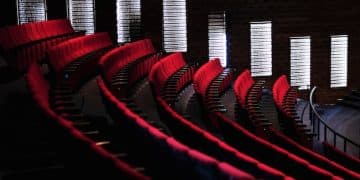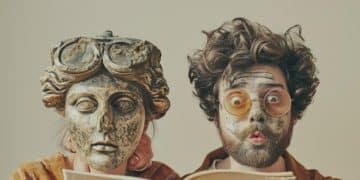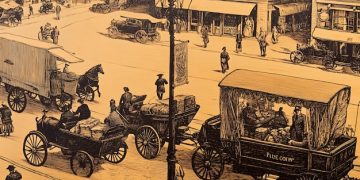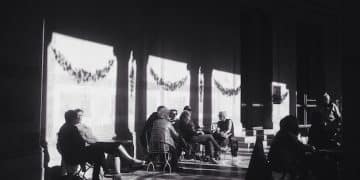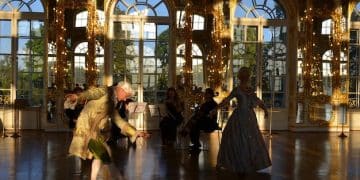Period Drama Set Design in 2025: Creating Historical Worlds
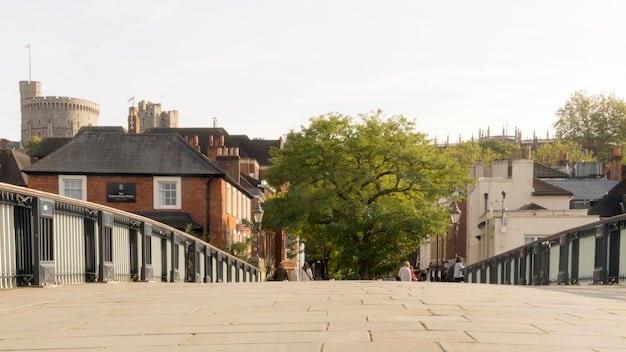
Period piece drama set design in 2025 involves production teams leveraging advanced technology, meticulous research, and sustainable practices to construct historically accurate and immersive environments that enhance storytelling and captivate audiences.
The allure of period dramas lies in their ability to transport us to different eras, offering a glimpse into the past. But what does the future hold for **period piece drama set design in 2025**? Production teams are increasingly tasked with not only recreating historical accuracy but also creating immersive worlds that captivate modern audiences.
The Evolution of Period Drama Set Design
Period drama set design has evolved significantly over the decades. What once relied heavily on painted backdrops and limited practical effects now incorporates cutting-edge technology and meticulous historical research to create truly believable worlds.
From Stagecraft to Cinematic Immersion
Early set designs were largely influenced by theatrical traditions, where sets were designed to be visually appealing but not necessarily historically accurate. Today, the emphasis is on creating immersive environments that draw the audience into the story.
The Role of Technology in Modern Set Design
Technology plays a crucial role in modern set design, from pre-visualization software that allows designers to plan every detail of a set to advanced materials and construction techniques that enable the creation of complex and realistic environments.
- Virtual Reality (VR) Pre-visualization: Allows directors and designers to experience the set before construction begins, making adjustments and identifying potential problems early on.
- 3D Printing: Used to create intricate props and set pieces with a high degree of accuracy and detail.
- Digital Matte Paintings: Enable the creation of expansive and detailed backgrounds that would be impossible to build in reality.
The integration of these technologies has revolutionized the way period dramas are produced, allowing for greater realism and visual impact.
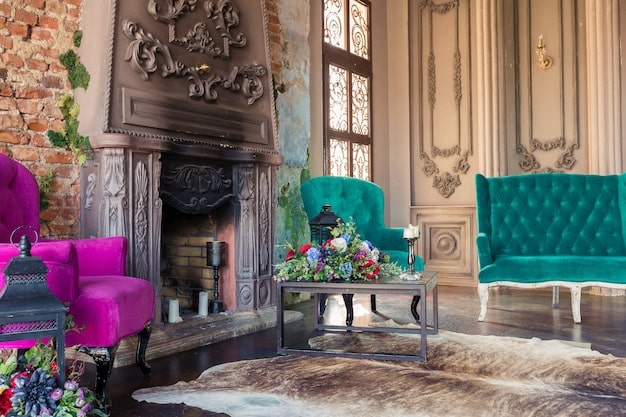
The industry continues to push boundaries, with production teams constantly seeking new ways to enhance the viewing experience. The future promises even more immersive and believable historical worlds.
Historical Accuracy: The Cornerstone of Period Set Design
At the heart of any successful period drama set design is a commitment to historical accuracy. Production teams invest significant time and resources in researching the period they are recreating, ensuring that every detail is authentic.
Extensive Research and Consultation
Before any construction begins, set designers and researchers delve into historical records, paintings, photographs, and other primary sources to gain a thorough understanding of the period’s architecture, furniture, and decor.
Sourcing Authentic Materials and Props
Whenever possible, production teams strive to use authentic materials and props in their sets. This can involve sourcing antique furniture, commissioning reproductions of historical textiles, and even recreating entire buildings based on historical blueprints.
Collaborating with Historians and Experts
To ensure the highest level of accuracy, many production teams collaborate with historians, archaeologists, and other experts who can provide valuable insights into the period being recreated. These experts can advise on everything from costume design to set dressing, helping to avoid anachronisms and ensure that the sets are as authentic as possible.
The pursuit of historical accuracy is a painstaking process, but it is essential for creating believable and engaging period dramas.
Sustainable Practices in Period Drama Set Design
As the entertainment industry becomes more aware of its environmental impact, sustainable practices are increasingly being adopted in period drama set design. Production teams are finding innovative ways to reduce waste, reuse materials, and minimize their carbon footprint.
Using Recycled and Reclaimed Materials
One of the most common sustainable practices is the use of recycled and reclaimed materials in set construction. This can involve using reclaimed wood for building facades, repurposing furniture from previous productions, and sourcing props from antique stores and salvage yards.
Reducing Waste and Promoting Recycling
Production teams are also implementing strategies to reduce waste and promote recycling on set. This can include using reusable containers for food and beverages, recycling construction waste, and donating unwanted props and set pieces to local charities and community organizations.
Employing Eco-Friendly Construction Techniques
Eco-friendly construction techniques are also gaining popularity in period drama set design. This can involve using non-toxic paints and adhesives, minimizing the use of plastics, and employing energy-efficient lighting and heating systems.
- Green Set Design: Designing sets with the end in mind, planning for disassembly and reuse of materials.
- Sustainable Sourcing: Prioritizing local suppliers to reduce transportation emissions and support local economies.
- Virtual Sets: Utilizing virtual sets where possible to minimize physical construction and material usage.
By adopting these sustainable practices, production teams can create stunning period dramas while minimizing their impact on the environment.
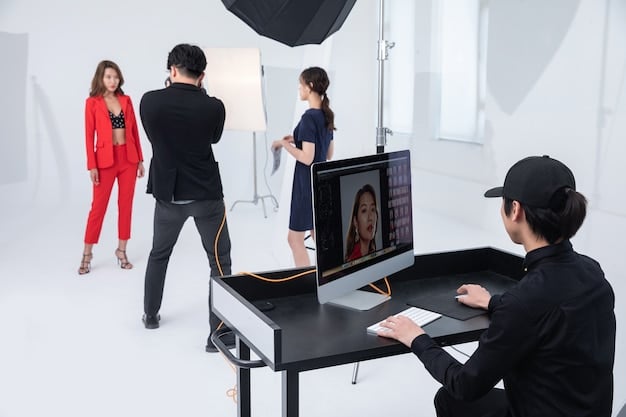
The commitment to sustainability is not just a trend but a necessary shift towards responsible filmmaking.
The Impact of Set Design on Storytelling
The set design in a period drama is not just a backdrop but an integral part of the storytelling process. A well-designed set can enhance the emotional impact of a scene, provide insights into the characters’ lives, and create a sense of immersion that draws the audience into the world of the story.
Creating Atmosphere and Mood
The colors, textures, and overall design of a set can have a profound impact on the atmosphere and mood of a scene. For example, a dimly lit, sparsely furnished room might convey a sense of poverty or isolation, while a brightly lit, opulently decorated ballroom might suggest wealth and extravagance.
Revealing Character and Social Context
The details of a set can also reveal important information about the characters who inhabit it. The furniture, artwork, and personal belongings in a character’s home can provide insights into their personality, social status, and values.
Enhancing Immersion and Believability
Perhaps most importantly, the set design can enhance the audience’s immersion in the world of the story. By creating a believable and authentic environment, the set designer can transport viewers to another time and place, allowing them to fully engage with the narrative.
Effective set design is key to breathing life into a period drama, elevating the narrative beyond simple dialogue and plot points.
Technological Advancements Shaping Set Design in 2025
Looking ahead to 2025, several technological advancements are poised to further revolutionize period drama set design. These innovations will enable production teams to create even more immersive, realistic, and sustainable environments than ever before.
Advanced Virtual and Augmented Reality
Virtual and augmented reality technologies will play an increasingly important role in set design. VR will allow designers and directors to pre-visualize sets in immersive 3D environments, while AR will enable them to overlay digital elements onto real-world sets, creating seamless integration between the physical and virtual worlds.
AI-Powered Set Design Tools
Artificial intelligence (AI) is also likely to have a significant impact on set design. AI-powered tools can assist with tasks such as historical research, set layout planning, and even the generation of realistic textures and materials.
Holographic Projections and Interactive Sets
Holographic projections and interactive sets are another exciting development on the horizon. Holographic projections can be used to create dynamic backgrounds and special effects, while interactive sets can respond to the actors’ movements and gestures, creating a more immersive and engaging experience for both the performers and the audience.
- Real-Time Rendering: Allowing for immediate adjustments and collaborative design in virtual environments.
- AI-Driven Historical Analysis: Automating the research process to ensure accuracy and detail.
- Modular Set Pieces: Creating adaptable sets that can be reconfigured for multiple scenes or productions.
These technological advancements promise to push the boundaries of what is possible in period drama set design, creating truly unforgettable viewing experiences.
Crafting Authentic Worlds: Case Studies in Period Drama Set Design
Examining successful period dramas reveals the intricate planning and artistry involved in set design. These case studies serve as benchmarks for future productions aiming for historical authenticity and immersive experiences.
“The Crown”: Recreating Royal Grandeur
“The Crown” is renowned for its meticulous attention to detail in recreating the royal residences and historical events of Queen Elizabeth II’s reign. The production team invested heavily in sourcing authentic furniture, artwork, and props, as well as recreating iconic locations such as Buckingham Palace and Westminster Abbey.
“Bridgerton”: A Whimsical Take on Regency Era
“Bridgerton” offers a more stylized and whimsical take on the Regency era, with vibrant colors, opulent costumes, and elaborate set designs. While not strictly historically accurate, the sets create a visually stunning and captivating world that perfectly complements the show’s lighthearted tone.
“Chernobyl”: Depicting a Nuclear Disaster
“Chernobyl” took a different approach, focusing on recreating the stark and desolate environment of the Chernobyl nuclear power plant and the surrounding areas. The production team used archival footage and photographs to ensure the accuracy of the sets, creating a haunting and unsettling atmosphere that underscored the gravity of the disaster.
Analyzing these diverse approaches highlights the range of possibilities in period drama set design, proving there’s no one-size-fits-all solution.
| Key Aspect | Brief Description |
|---|---|
| 🔍 Historical Accuracy | Meticulous research to ensure accurate representation of the era. |
| 🌱 Sustainable Practices | Using recycled materials and eco-friendly construction techniques. |
| 🎬 Storytelling Impact | Enhancing atmosphere and character through set design. |
| 🤖 Technological Advancements | AI and VR are transforming immersive set creation. |
Frequently Asked Questions
▼
Technology enhances historical accuracy, with VR pre-visualization and 3D printing for intricate details. AI helps streamline design and research, leading to more immersive and detailed set environments.
▼
Set designers conduct in-depth research using historical records, collaborate with experts, and source authentic materials whenever possible to ensure the era’s architecture and decor are genuinely represented.
▼
Sustainable practices minimize environmental impact through material recycling and eco-friendly builds. It reduces waste and promotes green filming, reflecting a commitment to responsible industry practices.
▼
Set design greatly influences the visual narrative by giving context to a specific historical period. It helps convey atmosphere, character, and immersion and makes the story more relatable and engaging.
▼
Future innovations include AI design tools and holographic projections enriching set designs. Virtual and real-time modifications will provide realistic and immersive environmental scenarios enhancing period authenticity.
Conclusion
As we look to the future of **period piece drama set design in 2025**, it is clear that the combination of historical accuracy, sustainable practices, technological advancements, and creative storytelling will continue to shape the industry. By embracing these elements, production teams can create truly immersive and unforgettable historical worlds that transport audiences to another time and place, enriching narrative experiences.
